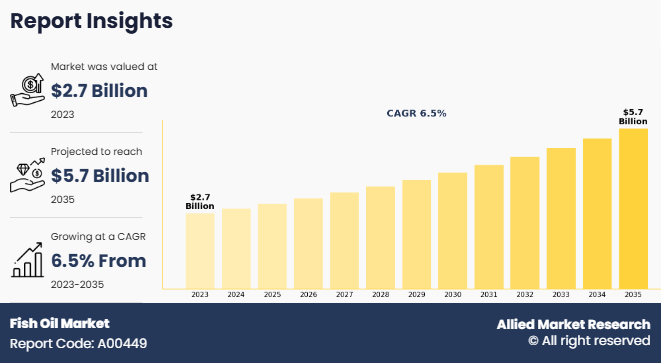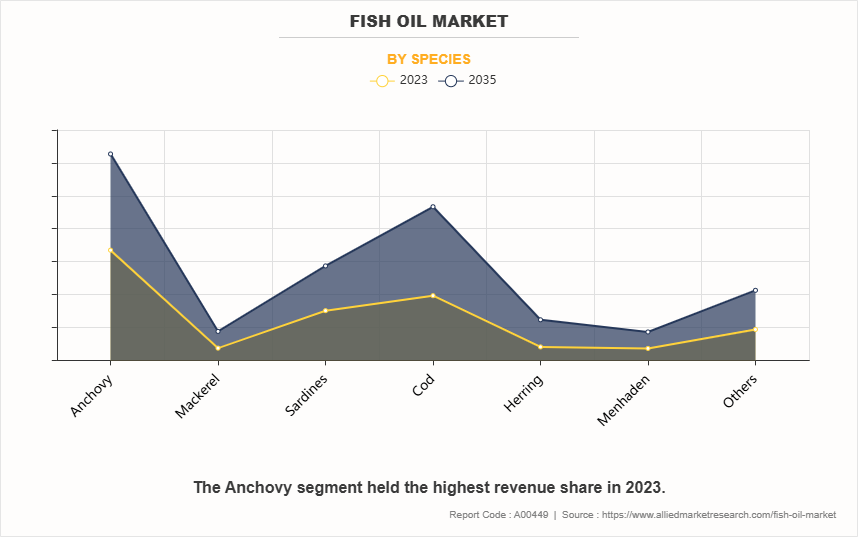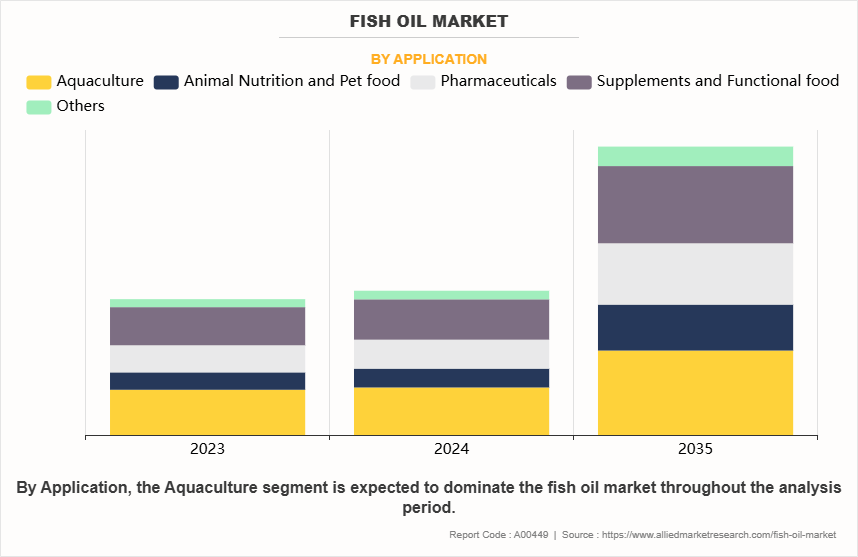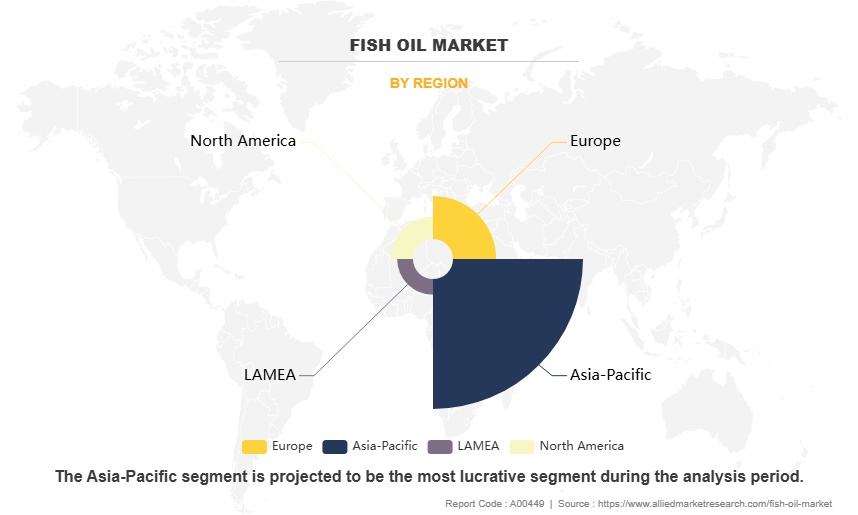Fish Oil Market Research, 2035
The global fish oil market size was valued at $2.7 billion in 2023, and is projected to reach $5.7 billion by 2035, growing at a CAGR of 6.5% from 2023 to 2035. Fish oil is derived from the tissues of oily fish that contain omega-3 fatty acids, such as eicosapentaenoic acids (EPA) and docosahexaenoic acids (DHA). Omega-3 fatty acids are largely used in the segments of aquaculture, animal nutrition & pet feed, supplements & functional food, pharmaceuticals, and others. Moreover, omega-3 fatty acid also helps in improving the cardiovascular system and also plays a major role in proper functioning of the nervous system. The growing awareness among medical professionals and public about the importance of omega-3 fatty acids has led to significant increase in fish oil consumption. Therefore, the companies are now expanding their nutraceutical product line with the addition of concentrated EPA and DHA. The rising demand of EPA and DHA in human nutrition has made a notable impact on the global fish oil market.

Key Takeaways
- By species, the anchovy segment dominated the market in 2023.
- By application, the aquaculture segment dominated the market in 2023.
- By region, Asia-Pacific dominated the market in terms of revenue in 2023. However, North America is anticipated to grow at the highest CAGR during the fish oil market forecast period.
Market Dynamics
Moreover, increase in technology development has ensured that aquaculture remains sustainable and has minimal environmental impacts. In addition, developments like on-land recirculating aquaculture systems, aquaponic systems, offshore systems and the use of information technology has boosted the aquaculture industry globally. Hence, surge in technology level in aquaculture industry is the major factor driving the fish oil market demand in terms of value sales. However, the rising volume of fish oil consumption in human nutrition creates a supply threat for aquaculture feed. Moreover, due to adverse environmental factors and regulatory impositions on fishing, the companies are unable to fulfill the demand-supply gap. The rising demands and lack of supply are primarily responsible for increasing costs of fish oil.
Moreover, the fish oil price rise is largely affected due to price fluctuations and market penetration of substitute products, such as vegetable proteins and other animals, as well as vegetable oils. Thus, continuous price fluctuations in the fish oil market are anticipated to hamper the fish oil market growth.
With a considerable decline in the count of several marine species, the governments across various countries have imposed quota restrictions on the practice of wild fish catching, as a measure to preserve marine life. This alternatively results in the rise of aquaculture, which is an effective intervention that involves the rearing of fish in artificially controlled environments. Moreover, the rearing of farmed fish is much more stable and secure from environmental threats, subsequently resulting in a steady supply of fish supplies, which is imperative for buyers such as large retail and the food and hotel industry. Fish oil is used as a prime ingredient for the aqua feed due to its high production yield, and a high protein yield. Hence, the consumption of fish oil is increasing along with the growth in the aquaculture industry.
Due to the decline in wild marine populations, governments worldwide have introduced quota restrictions on wild fish harvesting to protect marine ecosystems. This has driven the growth of aquaculture, where fish are raised in controlled environments. Aquaculture ensures a stable and secure fish supply, benefiting industries like retail, hospitality, and food services. Fish oil, rich in protein and offering high production efficiency, is a vital component in aqua feed. As aquaculture expands, the demand for fish oil continues to rise, driven by the need for reliable and sustainable fish sources in global markets.
Adverse climatic conditions largely restrain the growth of the fish oil market. El Nino is an adverse climatic phenomenon that develops in the central and east central parts of the Pacific and is characterized by the warming of ocean water and high air pressures. El Nino results in a major change of temperatures globally and causes high rainfall and fluctuations in air temperatures that badly affect agriculture and fishing activities along coastal areas in developing countries. El Nino reduces the upwelling of cold ocean water which causes food scarcity for fish and compels them to migrate to deeper waters, which subsequently hampers the global fish oil production in prime fishing areas such as Chile, Peru and also European countries that include Iceland, Denmark and Norway. El- Nino also hampers the transport activities in these coastal areas, resulting in an increased cost of transportation.
Segmentation Overview
The fish oil market is segmented into species, application, and region. By species, the market is categorized into anchovy, mackerel, sardines, cod, herring, menhaden, and others. By application, it is classified into aquaculture, animal nutrition & pet food, pharmaceuticals, supplements & functional food and others. Aquaculture is further segmented as sub-type into salmon and trout, marine fish, crustaceans, tilapias, eels, cyprinids, and others. By region, it is analyzed across North America (U.S., Canada, and Mexico), Europe (UK, Germany, Denmark, Norway, Belgium and rest of Europe), Asia-Pacific (China, Japan, India, Vietnam, Indonesia and rest of Asia-Pacific), and LAMEA (Latin America, Middle East, and Africa).
By Species
The anchovy segment to maintain its leadership status throughout the forecast period
Based on species, the anchovy segment held the major share of the market in 2023 Peruvian anchovy is the most caught fish in the world that contributes more than 38% of the global fish oil production. Anchovy fish oil is primarily consumed in aquaculture feed market of Europe and Chile. Moreover, due to the high concentration of EPA and DHA, anchovy fish oil has high demand in the human consumption market, particularly as supplement and functional food

By Application
The aquaculture segment to maintain its leadership status throughout the forecast period
Based on application, the aquaculture segment held the major share of the market in 2023. In the aquaculture industry, fish oil is primarily fed to species like salmon and trout, crustaceans, Eels, cyprinids, marine fish, carps and tilapias. Among them, highest percentage of fish oil is used for salmon and trout. In terms of aqua-grade fish oil consumption, Asia-Pacific, particularly China, is the major fish oil consumer in the world.

By Region
Asia-Pacific to maintain its dominance by 2035
Based on region, Asia-Pacific held the major share of the fish oil market in 2023. Fish oil is largely consumed as an aqua feed ingredient in China, Japan and India. In Japan, Omega 3 fish oil is largely consumed in pharmaceuticals and nutraceuticals. Country’s eicosapentaenoic acids (EPA) and docosahexaenoic acids (DHA) market has grown significantly over past five years due to growing health concerns among consumers.

Players operating in the market have adopted various developmental strategies to expand their fish oil market share, increase profitability, and remain competitive in the market. The key players operating in the fish oil industry include Omega Protein Corporation, FMC Corporation, Copeinca AS, Corpesca SA, Colpex International, TripleNine Group A/S, FF Skagen A/S, Pesquera Diamante S.A., Marvesa Holding N.V. and Pesquera Exalmar.
Key Benefits For Stakeholders
- This report provides a quantitative analysis of the market segments, current trends, estimations, and dynamics of the fish oil market analysis from 2023 to 2035 to identify the prevailing fish oil market opportunities.
- The market research is offered along with information related to key drivers, restraints, and opportunities.
- Porter's five forces analysis highlights the potency of buyers and suppliers to enable stakeholders make profit-oriented business decisions and strengthen their supplier-buyer network.
- In-depth analysis of the fish oil market segmentation assists to determine the prevailing market opportunities.
- Major countries in each region are mapped according to their revenue contribution to the global market.
- Market player positioning facilitates benchmarking and provides a clear understanding of the present position of the market players.
- The report includes the analysis of the regional as well as global fish oil market trends, key players, market segments, application areas, and market growth strategies.
Fish Oil Market Report Highlights
| Aspects | Details |
| Market Size By 2035 | USD 5.7 billion |
| Growth Rate | CAGR of 6.5% |
| Forecast period | 2023 - 2035 |
| Report Pages | 337 |
| By Species |
|
| By Application |
|
| By Region |
|
| Key Market Players | Colpex International S.A.C, Pesquera Exalmar, Corpesca SA, TripleNine Group A/S, Pesquera Diamante S.A., FF Skagen A/S, Omega Protein Corporation, FMC Corporation, Copeinca AS, Marvesa Holding N.V. |
Analyst Review
Innovation is the key for the growth of the global fish oil market in terms of value sales. In addition, developments such as on-land recirculating aquaculture systems, aquaponic systems, offshore systems and the use of information technology has boosted the aquaculture industry globally, which also resulted in fueling the fish oil market demand. According to the perspective of CXOs of the top companies in the market, the rising demand for long chain omega-3 fatty acid primarily drives the global fish oil market. However, impositions on the fishing quota and adverse climatic conditions such as the El Nino impede the fish oil market demand. The global fish oil market is witnessing consistent growth, fueled by increasing demand across aquaculture, pharmaceuticals, and nutritional supplements. With declining wild fish stocks due to overfishing and environmental concerns, aquaculture has become a sustainable solution, significantly boosting fish oil usage in feed. Fish oil, rich in omega-3 fatty acids, is also gaining popularity in human health applications, promoting heart, brain, and joint wellness. Major producers include Peru, Chile, and Nordic nations, while the Asia-Pacific region—especially China—leads in consumption. Despite ongoing challenges such as volatile raw material availability and sustainability issues, advancements in extraction methods and growing awareness of fish oil's health benefits are expected to propel market growth in the coming years. Presently, the aquaculture industry is the largest consumer of fish oil, as it acts as ideal energy source and provides essential fatty acids to farmed fish. On the other hand, CXOs are concerned about increasing demand-supply gap, which leads to price fluctuation of fish oil in the global market. However, CXOs are very optimistic about the rising demand for omega-3 in human nutrition applications, such as pharmaceutical and supplements & functional food**. This in turn fosters the market growth. Moreover, in North
America, fish oil is largely used in pharmaceuticals and supplements & functional food applications, due to the rising health awareness among consumers, which also result in fuelling the growth of the fish oil market.
The fish oil market registered a CAGR of 6.5% from 2024 to 2035.
Raise the query and paste the link of the specific report and our sales executive will revert with the sample.
The forecast period in the fish oil market report is from 2024 to 2035.
The top companies that hold the market share in the fish oil market Omega Protein Corporation, FMC Corporation, Copeinca AS, and others.
The fish oil market was valued at $2.7 billion in 2023, and is projected to reach $5.7 billion by 2035, registering a CAGR of 6.5% from 2024 to 2035.
The fish oil market report has 2 segments. The segments species and application.
The emerging regions in the fish oil market are likely to grow at a CAGR of more than 10.0% from 2025 to 2035.
Asia-Pacific will dominate the fish oil market by the end of 2035.
Loading Table Of Content...
Loading Research Methodology...



